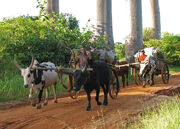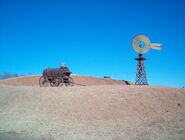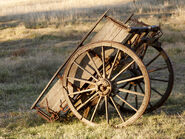| This article needs additional citations for verification. Please help improve this article by adding citations to reliable sources. Unsourced material may be challenged and removed. (June 2010) |

A Haitian hand cart.
A cart is a vehicle designed for transport, using two wheels and normally pulled by one or a pair of draught animals. A handcart is pulled or pushed by one or more people. It is different from a dray or wagon, which is a heavy transport vehicle with four wheels and normally at least two horses, which in turn is different from a carriage, which is used exclusively for transporting humans. The restriction of "carts" to two wheels has become less strictly observed since they were commonly horse-drawn, particularly for those pushed by people.
The draught animals used for carts may be horses or ponies, mules, oxen, water buffalo or donkeys, or even smaller animals such as goats or large dogs.
History[]

Hand-propelled wheel cart, Indus Valley Civilization (3000–1500 BCE). Housed at the National Museum, New Delhi.
Carts have been mentioned in literature as far back as the second millennium B.C. The Indian sacred book Rigveda states that men and women are as equal as two wheels of a cart. Hand-carts pushed by humans have been used around the world. In the 19th century, for instance, some Mormons travelling across the plains of the United States between 1856 and 1860 used handcarts.
Carts were often used for judicial punishments, both to transport the condemned – a public humiliation in itself (in Ancient Rome defeated leaders were often carried in the victorious general's triumph) – and even, in England until its substitution by the whipping post under Queen Elizabeth I, to tie the condemned to the cart-tail and administer him or her a public whipping.
Types of cart[]
Larger carts may be drawn by animals, such as horses, mules, or oxen. They have been in continuous use since the invention of the wheel, in the 5th millennium BC. Carts may be named for the animal that pulls them, such as horsecart or oxcart. In modern times, horsecarts are used in competition while draft horse showing. A dogcart, however, is usually a cart designed to carry hunting dogs: an open cart with two cross-seats back to back; the dogs could be penned between the rear-facing seat and the back end.
The term " cart " (synonymous in this sense with chair) is also used for various kinds of lightweight, two-wheeled carriages, some of them sprung carts (or spring carts), especially those used as open pleasure or sporting vehicles. They could be drawn by a horse, pony or dog. Examples include:
- cocking cart: short-bodied, high, two-wheeled, seat for a groom behind the box; for tandem driving[1]
- dogcart: light, usually one horse, commonly two-wheeled and high, two transverse seats set back to back
- donkey cart: underslung axle, two lengthwise seats; also called pony cart, tub-cart

A donkey cart used in the Gambia

Tourist carts in Petra Siq (Jordan)
- float: a dropped axle to give an especially low loadbed, for carrying heavy or unstable items such as milk churns. The name survives today as a milkfloat.
- governess cart: light, two-wheeled, entered from the rear, body partly or wholly of wickerwork, seat for two persons along each side; also called governess car, tub-cart

Carts from different Malay regions, exhibited at the Muzium Negara.
- ralli cart: light, two-wheeled, horse-drawn, for two persons facing forward, or four, two facing forward and two rearward. The seat is adjustable fore-and-aft to keep the vehicle balanced for two or four people.
- stolkjaerre: two-wheeled, front seat for two, rear seat for the driver; used in Norway
- tax cart: spring cart, formerly subject to a small tax in England; also called taxed cart
- Whitechapel cart: spring cart, light, two-wheeled, especially for family or light delivery service
The builder of a cart may be known as a cartwright; the surname "Carter" also derives from the occupation of transporting goods by cart or wagon.

Ox carts in Madagascar
Carts have many different shapes, but the basic idea of transporting material (or maintaining a collection of materials in a portable fashion) remains. Carts may have a pair of shafts, one along each side of the draught animal that supports the forward-balanced load in the cart. The shafts are supported by a saddle on the horse. Alternatively (and normally where the animals are oxen or buffalo), the cart may have a single pole between a pair of animals. The draught traces attach to the axle of the vehicle or to the shafts. The traces are attached to a collar (on horses), to a yoke (on other heavy draught animals) or to a harness on dogs or other light animals.
Traces are made from a range of materials depending on the load and frequency of use. Heavy draught traces are made from iron or steel chain. Lighter traces are often leather and sometimes hemp rope, but plaited horse-hair and other similar decorative materials can be used.
The dray is often associated with the transport of barrels, particularly of beer.
Of the cart types not animal-drawn, perhaps the most common example today is the shopping cart (British English: shopping trolley), which has also come to have a metaphorical meaning in relation to online purchases (here, British English uses the metaphor of the shopping basket). Shopping carts first made their appearance in Oklahoma City in 1937.
In golf, both manual push or pull and electric golf trolleys are designed to carry a golfers bag, clubs and other equipment. Also, the golf cart, car, or buggy, is a powered vehicle that carries golfers and their equipment around a golf course faster and with less effort than walking.
A Porter's trolley is a type of small, hand-propelled wheeled platform. This can also be called a baggage cart. since the 13th century.[citation needed]
Autocarts are a type of small, hand-propelled wheeled utility carts having a pivoting base for collapsible storage in vehicles. They eliminate the need for plastic or paper shopping bags and are also used by tradespersons to carry tools, equipment or supplies.
A soap-box cart (also known as a Billy Cart, Go-Cart, Trolley etc.) is a popular children's construction project on wheels, usually pedaled, but also intended for a test race.
The term "Go-Kart", which exists since 1959, also shortened as "Kart", an alternative spelling of "cart", refers to a tiny race car with frame and two-stroke engine; the old term go-cart originally meant a sedan chair or an infant walker
Gallery[]
See also[]
- Araba
- Baby transport
- Baggage cart
- Barouche
- Bicycle trailer
- Brougham
- Bullock cart
- Cabriolet
- Carriage
- Chariot
- Float
- Golf cart
- Governess cart
- Guard stone
- Hand truck
- Hansom cab
- Hobcart
- Horse-drawn vehicles
- Jaunting car
- Landau
- Lorry (horse-drawn)
- Ralli car
- Red River ox cart
- Rickshaw
- Rully
- Shopping cart
- Sicilian cart
- Sprung cart
- Sulky
- Taxicab
- Toy wagon
- Trolley (horse-drawn)
- Tumbril
- Un-sprung cart
- Wagon
- Wain
- Wheel
- Wheelbarrow
- Wheel chair
References[]
- ↑ CAAOnline: Carriage Tour. The Carriage Association of America, Inc.
External links[]
| Find more about Cart on Wikipedia's sister projects: | |
| Definitions from Wiktionary | |
| Images and media from Commons | |
| Learning resources from Wikiversity | |
| News stories from Wikinews | |
| Quotations from Wikiquote | |
| Source texts from Wikisource | |
| Textbooks from Wikibooks | |
| This page uses some content from Wikipedia. The original article was at cart. The list of authors can be seen in the page history. As with Tractor & Construction Plant Wiki, the text of Wikipedia is available under the Creative Commons by Attribution License and/or GNU Free Documentation License. Please check page history for when the original article was copied to Wikia |








